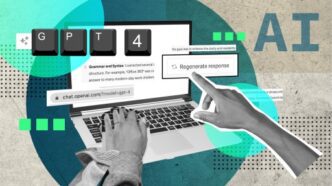Artificial Intelligence is moving fast—reshaping how we live, work, and interact across industries from medicine to logistics. But to truly understand how far we’ve come—and where we’re heading—Stanford’s 2025 AI Index Report offers one of the most detailed pictures of the AI landscape today. Packed with data, this latest edition reveals breakthroughs in research, the accelerating role of industry, geopolitical rivalries, and the urgent need for responsible development. Let’s break down the key takeaways and what they mean for the future.
Major Gains in AI Research—and a Tighter Race Between Open and Closed Models
The past year has brought remarkable advances in AI performance. Benchmark tests like MMLU, GPQA, and SWE-bench show some models improving by as much as 67%. In real-world tasks, AI is starting to surpass human coders and is now capable of generating increasingly sophisticated video content.
Open-source models also made significant progress in 2024, narrowing the performance gap with proprietary models. As a result, advanced AI capabilities are becoming more accessible than ever. Most development is now driven by private companies, though universities continue to shape foundational research.
The U.S. remains the dominant force in AI innovation, with 40 top-tier models built in 2024. But China is catching up quickly, delivering 15 frontier models and signaling a fierce global race for AI leadership. Still, the report stresses that current AI systems—despite their speed—struggle with tasks requiring deeper reasoning and logic. That’s a concern for applications where accuracy isn’t optional.
AI Fuels Breakthroughs in Science and Research
AI’s role in science is growing rapidly. From predicting protein structures with tools like AlphaFold 3 to discovering new crystals for robotics via GNoME, the technology is unlocking problems once thought unsolvable. These breakthroughs aren’t going unnoticed—AI-powered discoveries have even earned recognition at the Nobel level. It’s becoming clear that AI isn’t just helping researchers work faster—it’s helping them ask better questions.
Real-World Adoption Is Soaring
The AI Index also shows that AI is now embedded in daily life. In healthcare, for instance, 223 AI-powered medical devices were approved by the FDA in 2023 alone. Meanwhile, autonomous vehicles are going mainstream. Waymo is logging over 150,000 driverless rides per week in the U.S., and Baidu’s Apollo Go is making self-driving more affordable in China.
On the business side, AI spending is skyrocketing. U.S. companies led the way with $109.1 billion invested in AI in 2024—far outpacing China and the U.K. This funding surge has boosted AI deployment in areas like logistics, customer service, and manufacturing, where early adopters are already seeing major productivity gains.
Cheaper, Faster AI—But Still Not Green Enough
A big win in 2024 was the cost drop for running AI models. Operating GPT-3.5, for instance, is now 280 times cheaper than it was just two years ago. That’s opened doors for smaller companies and startups to join the AI revolution.
However, this rapid growth comes with an environmental cost. Training powerful models like GPT-4 emitted more than 5,000 tons of CO₂. And while hardware and software efficiency is improving, the energy demands of these systems continue to rise. The report makes it clear—if AI is going to scale sustainably, cleaner energy solutions are urgently needed.
Governments Step In: Rules, Risks, and Regulations
AI’s influence has become too big to ignore, and governments are stepping up. In 2024 alone, the U.S. passed 59 new AI-related laws. Meanwhile, countries like Canada, Saudi Arabia, and China are pouring billions into AI as part of national growth strategies.
Global organizations such as the OECD, EU, and UN are also developing governance frameworks to ensure AI is used responsibly. But the report warns that Responsible AI (RAI) efforts are still in early stages. AI-related incidents are rising, and there’s growing pressure to make these systems safer, more transparent, and more accountable.
Building the Workforce: AI Education on the Rise
Education is trying to keep up. More students than ever are pursuing AI-related degrees—especially at the master’s level. Around the world, AI and computer science are being integrated into school curricula. Yet gaps remain, particularly in under-resourced regions.
In the U.S., for example, schools are struggling with training and access to qualified instructors. To build a diverse AI talent pool, the report stresses the importance of making education inclusive and equitably distributed.
Public Opinion: Hopeful, but Watchful
People are cautiously optimistic about AI. Many see its benefits but worry about fairness, safety, and job security. Trust in AI companies to handle personal data is waning. Still, most support regulation and are in favor of stronger privacy protections.
As for work, most employees don’t fear losing their jobs to AI—but they do expect their roles to evolve. From automating routine tasks to demanding new skills, AI is reshaping how we work, not just what we do.
The Big Picture
The 2025 AI Index Report makes one thing clear: AI is no longer emerging—it’s here, and it’s accelerating. From transforming industries to reshaping science, AI’s influence is undeniable. But progress must be balanced with responsibility. Governance, sustainability, and equitable access aren’t side issues—they’re central to ensuring AI serves everyone.
Moving forward, the collaboration between policymakers, researchers, companies, and educators will be critical. Because while AI promises a better future, getting there will take work—and wisdom.













